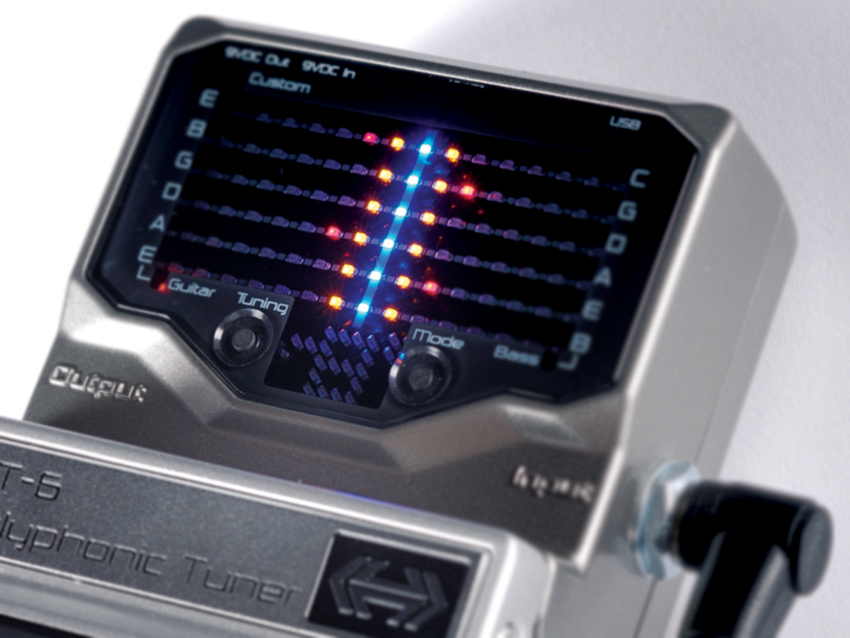MusicRadar Verdict
Get over any aesthetic niggles, plus the £30 price difference between this and its rival, and the HT-6 is a serious contender for your cash.
Pros
- +
Easy to use. Clear display. Sturdy build.
Cons
- -
Looks a little clunky.
MusicRadar's got your back

Hardwire HT-6 Polyphonic Tuner

Hardwire HT-6 Polyphonic Tuner
There's no better catalyst for progression than a bit of healthy competition and you're seeing the latest trend unfolding right now. That's right, we're talking about polyphonic guitar tuning.
Yes, tuning your guitar might have all the rock-star appeal of completing a tax return on time, but much like your annual fiscal documentation, it's got to be done, so why not do it in style?
"Just strum all the strings and the HT-6 will work the rest out for you."
HardWire's HT-6 polyphonic tuner follows on the heels of TC Electronic's PolyTune. It features the all-important polyphonic single-string tuning, with either 'normal' or 'strobe' display settings.
In addition to this, there are some extra features courtesy of its custom tunings and fret offset function. It's all a far cry from a trio of coloured lights.
The display gives you a matrix of 90 LEDs. That's six horizontal rows with 15 lights for each string. It's fast and doesn't skip around too much, which is a flaw in a lot of tuners. Just strum all the strings and the HT-6 will work the rest out for you.
Much like that long-extinct breed of bloke down the pub who, with a lit fag balanced behind the nut, was able to tune his guitar perfectly just by strumming a chord and sensing which notes were out.
The fret offset feature is handy if you're using standard-interval low tunings or a capo to transpose in the opposite direction. Say, for example, you'd tuned down a whole tone across the strings.
Want all the hottest music and gear news, reviews, deals, features and more, direct to your inbox? Sign up here.
Then, with the guitar roughly in tune, you'd hold the footswitch down for a couple of seconds and strum the strings. The HT-6 detectsyour guitar's pitch and calibrates itself to work at that tuning.
You can also offset it manually by pressing the Mode (down) or Tuning (up) switches after holding the footswitch down. It'll go up to six semitones in either direction, but it's worth noting that you have to be within the ballpark of the tuning you're trying to hit first for it to work at its best.
There's also a drop D mode, which functions polyphonically too, but if you want to tune to any other dropped or open tunings, you'll need to use the single-note mode.
Take a look at the back of the pedal and you'll see two power power supply (the HT-6 also works from a standard PP3 battery), the other is for daisy-chaining power from your adaptor to the rest of your pedals.
In addition, there's a micro-USB socket, which will eventually offer the ability to upgrade the HT-6's software for different tunings.
The HT-6 equals its rival in many areas and, if we're splitting hairs, beats it with its LED count. It's also arguably easier to use, since the display's transition between polyphonic and single-string tuning is less disruptive.
Where it will divide opinion is over its looks, size and price. Depending on your point of view, it's either sturdy and purposeful, or big and slightly ugly.

Stuart has been working for guitar publications since 2008, beginning his career as Reviews Editor for Total Guitar before becoming Editor for six years. During this time, he and the team brought the magazine into the modern age with digital editions, a Youtube channel and the Apple chart-bothering Total Guitar Podcast. Stuart has also served as a freelance writer for Guitar World, Guitarist and MusicRadar reviewing hundreds of products spanning everything from acoustic guitars to valve amps, modelers and plugins. When not spouting his opinions on the best new gear, Stuart has been reminded on many occasions that the 'never meet your heroes' rule is entirely wrong, clocking-up interviews with the likes of Eddie Van Halen, Foo Fighters, Green Day and many, many more.